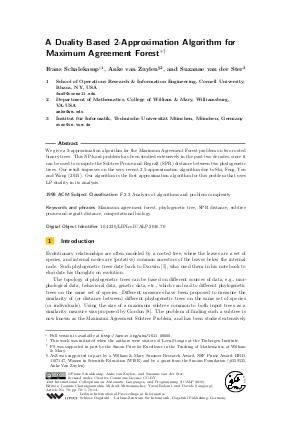A Duality Based 2-Approximation Algorithm for Maximum Agreement Forest
Authors Frans Schalekamp, Anke van Zuylen, Suzanne van der Ster
-
Part of:
Volume:
43rd International Colloquium on Automata, Languages, and Programming (ICALP 2016)
Part of: Series: Leibniz International Proceedings in Informatics (LIPIcs)
Part of: Conference: International Colloquium on Automata, Languages, and Programming (ICALP) - License:
 Creative Commons Attribution 3.0 Unported license
Creative Commons Attribution 3.0 Unported license
- Publication Date: 2016-08-23
File

PDF
LIPIcs.ICALP.2016.70.pdf
- Filesize: 0.61 MB
- 14 pages
Document Identifiers
Subject Classification
Keywords
- Maximum agreement forest
- phylogenetic tree
- SPR distance
- subtree prune-and-regraft distance
- computational biology
Metrics
- Access Statistics
-
Total Accesses (updated on a weekly basis)
0Document
0Metadata
Abstract
We give a 2-approximation algorithm for the Maximum Agreement Forest problem on two rooted binary trees. This NP-hard problem has been studied extensively in the past two decades, since it can be used to compute the Subtree Prune-and-Regraft (SPR) distance between two phylogenetic trees. Our result improves on the very recent 2.5-approximation algorithm due to Shi, Feng, You and Wang (2015). Our algorithm is the first approximation algorithm for this problem that uses LP duality in its analysis.
Cite As Get BibTex
Frans Schalekamp, Anke van Zuylen, and Suzanne van der Ster. A Duality Based 2-Approximation Algorithm for Maximum Agreement Forest. In 43rd International Colloquium on Automata, Languages, and Programming (ICALP 2016). Leibniz International Proceedings in Informatics (LIPIcs), Volume 55, pp. 70:1-70:14, Schloss Dagstuhl – Leibniz-Zentrum für Informatik (2016)
https://doi.org/10.4230/LIPIcs.ICALP.2016.70
BibTex
@InProceedings{schalekamp_et_al:LIPIcs.ICALP.2016.70,
author = {Schalekamp, Frans and van Zuylen, Anke and van der Ster, Suzanne},
title = {{A Duality Based 2-Approximation Algorithm for Maximum Agreement Forest}},
booktitle = {43rd International Colloquium on Automata, Languages, and Programming (ICALP 2016)},
pages = {70:1--70:14},
series = {Leibniz International Proceedings in Informatics (LIPIcs)},
ISBN = {978-3-95977-013-2},
ISSN = {1868-8969},
year = {2016},
volume = {55},
editor = {Chatzigiannakis, Ioannis and Mitzenmacher, Michael and Rabani, Yuval and Sangiorgi, Davide},
publisher = {Schloss Dagstuhl -- Leibniz-Zentrum f{\"u}r Informatik},
address = {Dagstuhl, Germany},
URL = {https://drops.dagstuhl.de/entities/document/10.4230/LIPIcs.ICALP.2016.70},
URN = {urn:nbn:de:0030-drops-62149},
doi = {10.4230/LIPIcs.ICALP.2016.70},
annote = {Keywords: Maximum agreement forest, phylogenetic tree, SPR distance, subtree prune-and-regraft distance, computational biology}
}
Author Details
References
-
Benjamin L. Allen and Mike Steel. Subtree transfer operations and their induced metrics on evolutionary trees. Annals of Combinatorics, 5(1):1-15, 2001.

-
Maria Luisa Bonet, Katherine St John, Ruchi Mahindru, and Nina Amenta. Approximating subtree distances between phylogenies. Journal of Computational Biology, 13(8):1419-1434, 2006.

- Magnus Bordewich, Catherine McCartin, and Charles Semple. A 3-approximation algorithm for the subtree distance between phylogenies. Journal of Discrete Algorithms, 6(3):458-471, 2008. URL: http://dx.doi.org/10.1016/j.jda.2007.10.002.
- Magnus Bordewich and Charles Semple. On the computational complexity of the rooted subtree prune and regraft distance. Ann. Comb., 8(4):409-423, 2004. URL: http://dx.doi.org/10.1007/s00026-004-0229-z.
- Charles Darwin. Notebook B: Transmutation of species (1837-1838). In: John van Wyhe: The Complete Work of Charles Darwin Online, 2002. URL: http://darwin-online.org.uk/.
-
Martin Farach and Mikkel Thorup. Optimal evolutionary tree comparison by sparse dynamic programming. In FOCS'94: Proceedings of 35th Annual Symposium on Foundations of Computer Science, pages 770-779. IEEE, 1994.

-
Martin Farach and Mikkel Thorup. Sparse dynamic programming for evolutionary-tree comparison. SIAM Journal on Computing, 26(1):210-230, 1997.

-
A. D. Gordon. A measure of the agreement between rankings. Biometrika, 66(1):7-15, 1979.

- Jotun Hein, Tao Jiang, Lusheng Wang, and Kaizhong Zhang. On the complexity of comparing evolutionary trees. Discrete Applied Mathematics, 71(1-3):153-169, 1996. URL: http://dx.doi.org/10.1016/S0166-218X(96)00062-5.
- Estela M. Rodrigues. Algoritmos para Comparação de Árvores Filogenéticas e o Problema dos Pontos de Recombinação. PhD thesis, University of São Paulo, Brazil, 2003. Chapter 7, available at URL: http://www.ime.usp.br/~estela/studies/tese-traducao-cp7.ps.gz.
- Estela M. Rodrigues, Marie-France Sagot, and Yoshiko Wakabayashi. The maximum agreement forest problem: approximation algorithms and computational experiments. Theoretical Computer Science, 374(1-3):91-110, 2007. URL: http://dx.doi.org/10.1016/j.tcs.2006.12.011.
- Frans Schalekamp, Anke van Zuylen, and Suzanne van der Ster. A duality based 2-approximation algorithm for maximum agreement forest. CoRR, abs/1511.06000, 2015. URL: http://arxiv.org/abs/1511.06000.
- Feng Shi, Qilong Feng, Jie You, and Jianxin Wang. Improved approximation algorithm for maximum agreement forest of two rooted binary phylogenetic trees. Journal of Combinatorial Optimization, 2015. URL: http://dx.doi.org/10.1007/s10878-015-9921-7.
- Mike Steel and Tandy Warnow. Kaikoura tree theorems: Computing the maximum agreement subtree. Information Processing Letters, 48(2):77-82, November 1993. URL: http://dx.doi.org/10.1016/0020-0190(93)90181-8.
- Chris Whidden, Robert G. Beiko, and Norbert Zeh. Fixed-parameter algorithms for maximum agreement forests. SIAM Journal on Computing, 42(4):1431-1466, 2013. URL: http://dx.doi.org/10.1137/110845045.
- Chris Whidden and Norbert Zeh. A unifying view on approximation and FPT of agreement forests. In Algorithms in Bioinformatics, volume 5724 of Lecture Notes in Computer Science, pages 390-402. Springer Berlin Heidelberg, 2009. URL: http://dx.doi.org/10.1007/978-3-642-04241-6_32.
- Yufeng Wu. A practical method for exact computation of subtree prune and regraft distance. Bioinformatics, 25(2):190-196, 2009. URL: http://dx.doi.org/10.1093/bioinformatics/btn606.
- Yufeng Wu and Jiayin Wang. Fast computation of the exact hybridization number of two phylogenetic trees. In Bioinformatics Research and Applications, volume 6053 of Lecture Notes in Computer Science, pages 203-214. Springer Berlin Heidelberg, 2010. URL: http://dx.doi.org/10.1007/978-3-642-13078-6_23.
